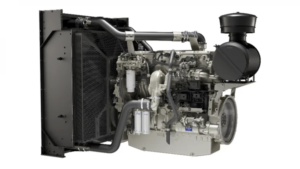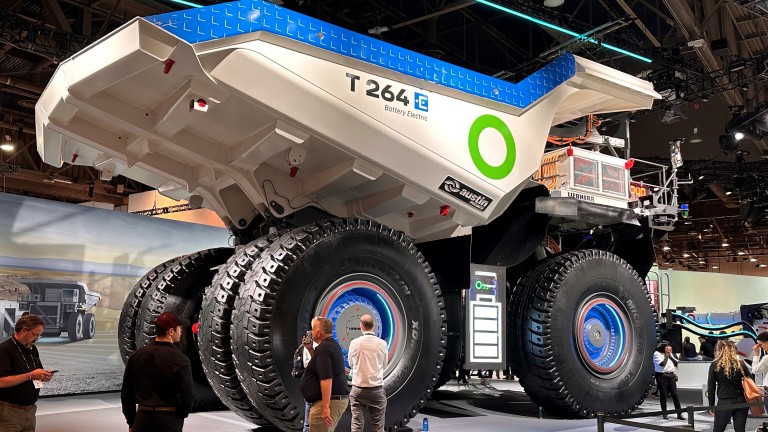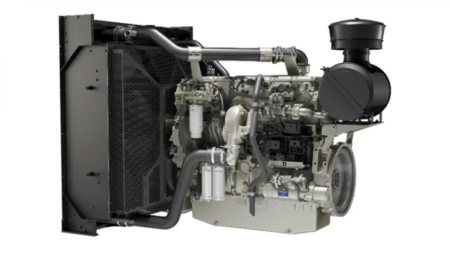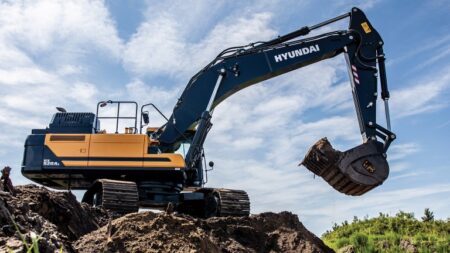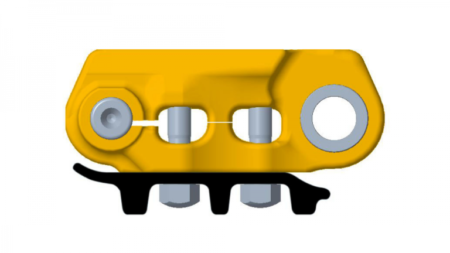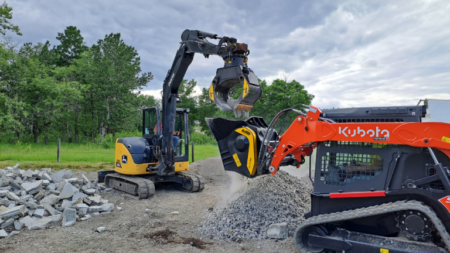At this year’s MINExpo, Fortescue Metals Group and Liebherr expanded their partnership to include a $2.8 billion investment in developing and deploying a range of 475 zero-emission Liebherr machines to Fortescue’s operations in Western Australia.
This historic deal — the largest in Liebherr’s 75-year history — is set to revolutionize mining operations by introducing carbon-free technology at scale, significantly reducing diesel emissions and creating one of the world’s largest zero-emission mining fleets.
The companies are committed to having the comprehensive and large-scale zero-emission mining ecosystem operational by 2030, representing a major breakthrough in the pursuit of a mining industry that isn’t reliant on fossil fuels.
Both companies have confirmed that customers will be able to access this ecosystem for their own operations in the coming years.
Driving forward with the autonomous battery-electric T 264
Also at the event, Liebherr and Fortescue unveiled the jointly developed autonomous battery-electric T 264 truck. Of the 475 machines that make up the deal, 360 will be autonomous T 264 trucks, featuring advanced autonomous technology and a battery-electric power system developed by Fortescue Zero, the technology division of Fortescue. This marks a significant leap from the initial partnership announced in 2022, which included only 120 trucks.
Scalable zero-emission technology for the future
All trucks in the fleet will be equipped with Fortescue Zero’s zero-emission battery power system and the jointly developed Autonomous Haulage Solution (AHS) — both of which were designed to be scalable and retrofitted onto existing Liebherr haul trucks. This ensures that the trucks can easily adapt as new technologies emerge.
Intelligent fleet management with Autonomous Haulage Solution
The AHS also includes an energy management system that intelligently coordinates energy management across the fleet of autonomous vehicles, ensuring efficient operations without idle time for recharging.
“We wanted to design and build an intelligent, state-of-the-art AHS that not only includes the know-how from both an OEM and a mining operator generated over the last few years but will also be able to integrate with new zero-emission solutions in the future,” says Oliver Weiss, executive vice president of R&D, engineering, and production at Liebherr-Mining Equipment SAS. “Therefore, control and command of zero-emission mining technologies were included in the AHS from the outset. The fleet management assignment engine at the core of the AHS monitors fleet energy levels so that jobs and energy replenishment tasks can be assigned efficiently within zero-emission fleets equipped with this system.”
Fast charging for battery-electric mining trucks
Fortescue has developed a stationary fast-charging solution to support the autonomous battery-electric trucks. The chargers, which come with robotic connection options, can deliver up to 6 MW of power and charge a T 264 truck’s battery in just 30 minutes. This rapid charging ensures that the trucks operate efficiently and without extended downtime.
Dino Otranto, CEO of Fortescue Metals, highlights the significance of their expertise in autonomy. “We have more than 200 autonomous trucks across our mine sites, travelling the equivalent of two trips to the moon and back each month. It is imperative that they operate efficiently and at maximum capacity. We have used our strong track record of being a first mover in autonomy and our technological know-how to derisk zero-emission fleets to enable the industry to break free from the pilots and prototypes. The fully integrated AHS will be a game changer for us in reducing our carbon emissions.”
Availability of the T 264 autonomous battery-electric trucks
The approximately 360-strong T 264 truck fleet has already begun arriving at Fortescue’s Western Australian operations, with the first trucks delivered to Fortescue’s Eliwana mine in October 2023. The initial 240-tonne capacity trucks will be converted to zero-emission powertrains before 2030, but most of the fleet will be supplied in battery-electric configuration when they first arrive.
The transition from human drivers to autonomous operations is a significant step forward, with the T 264 trucks arriving autonomy-ready and progressively deployed to autonomous operations across Fortescue’s sites.
The T 264 battery-electric truck will commence onsite validation at the end of 2025. Four autonomous trucks are currently in validation at Fortescue’s testing site, with the first deployment of operational autonomous trucks expected in the first quarter of 2025. All T 264 trucks are arriving autonomy-ready and will be progressively deployed to autonomous operations across Fortescue’s sites. Validation of the full autonomous battery-electric solution is expected to be complete in early 2026.
Expanding capabilities with electric mining equipment
In addition to the trucks, Fortescue will receive 55 Liebherr R 9400 E electric excavators and 60 battery-powered PR 776 dozers. The excavators will be deployed in both backhoe and face shovel configurations
Fortescue first adopted Liebherr’s electric excavator technology in 2023, with the commissioning of Australia’s first operational electric excavator in December of that year. Three R 9400 E excavators are already operational across Fortescue’s sites.
Pushing ahead with battery-powered dozers
Liebherr and Fortescue will also combine their expertise to jointly develop a zero-emission dozer. Fortescue’s battery power system will be integrated into an electric version of Liebherr’s flagship mining dozer, the PR 776.
Once developed, Liebherr will supply Fortescue with 60 units of the zero-emission dozing solution to meet Fortescue’s Real Zero targets.
Benefits of electrification
Electrification stands at the forefront of strategies to reduce greenhouse gas emissions in the mining industry. By transitioning to electric mining equipment, mining companies can drastically decrease their carbon footprint and enhance their sustainability performance.
Electric mining equipment offers numerous benefits, including reduced energy consumption, lower operating costs, and improved safety. Moreover, electrification helps mining companies fulfill their ESG commitments and supports a smoother energy transition.
Increasing organizational capacity
Ensuring the successful delivery of the machines requires significant investment from both Liebherr and Fortescue.
“We are on track with our investment plans to develop our global infrastructure to ensure that we can accommodate the expansion of our business and provide our customers with larger quantities and a wider range of zero-emission technology,” says Michael Arndt, executive vice president of service and quality at Liebherr-Mining Equipment SAS. “We will see the outcomes of these investments soon, with many more milestones to be implemented over the next five years.”
As mining solutions continue to advance, the capability to deliver and service these technologies must also expand. To support this growth, significant investments are being made in infrastructure, workforce development, and remote support services.
Fortescue is also scaling up its capacity to supply the hundreds of batteries required for trucks and dozers in its zero-emission fleet.
Ensuring local capacity
All 475 machines of this deal will become part of Fortescue’s iron ore hub in the Pilbara region of Western Australia. As such, Liebherr-Australia — Liebherr’s sales and service company in the country — has already begun its preparations for supporting this enormous fleet.
“This large volume of machinery presents a unique growth opportunity for Liebherr-Australia. We are significantly ramping up investments in our branches, reman facilities, and our people to ensure we have the capacity to safely and efficiently maintain not only this equipment but that of our other customers,” says Trent Wehr, managing director of Liebherr-Australia.
Pioneering net zero mining for a sustainable future
The Fortescue-Liebherr partnership marks a major milestone in the shift towards a zero-emission mining industry. This $2.8 billion collaboration sets a new standard for decarbonizing heavy operations, combining advanced technology with a shared commitment to sustainability. This collaboration sets a new standard for decarbonizing heavy operations, combining advanced technology with a shared commitment to sustainability, and has significant implications for the trucking industry as well.
As Fortescue’s zero-emission fleet rolls out, the impact will extend beyond the companies involved, offering a scalable model for global mining operations. As more companies join the movement toward green mining technologies, the partnership stands as a blueprint for how collaboration and cutting-edge technology can drive meaningful progress toward a zero-emission future.
Read the full article here


